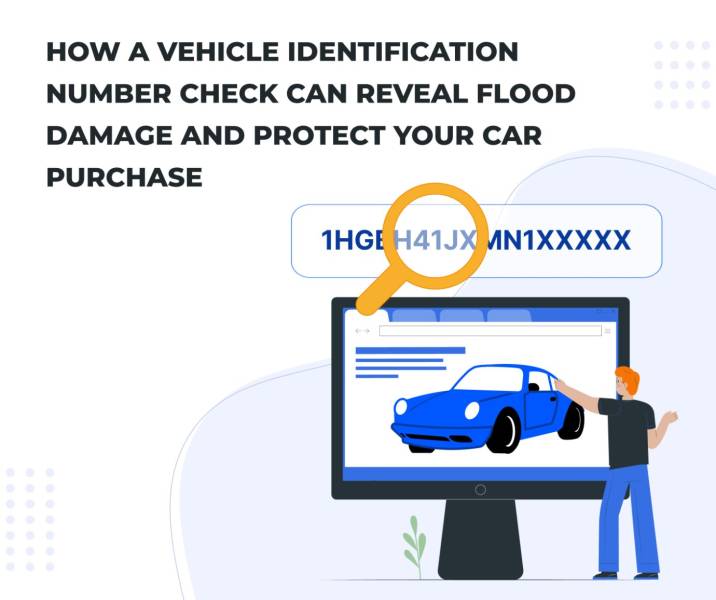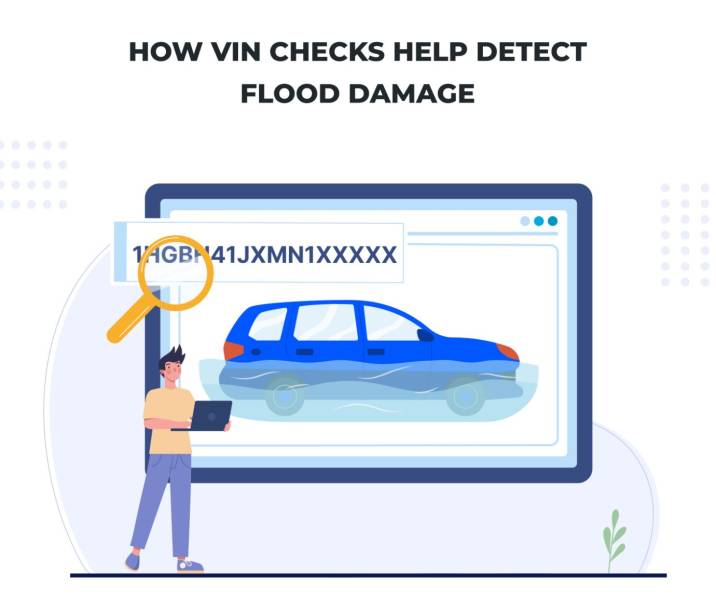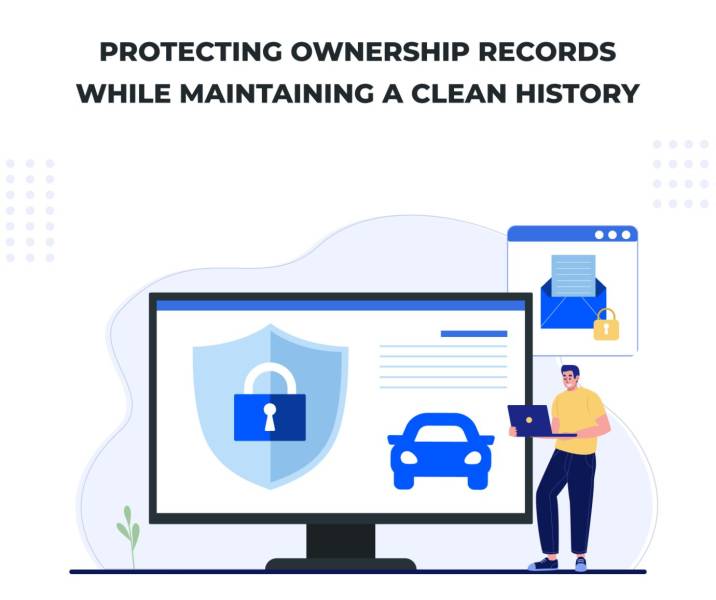Buying a used vehicle without checking its background can lead to costly surprises—especially when flood damage is involved. Using carfast express, drivers can quickly access a vehicle’s history and uncover hidden issues tied to its VIN. A thorough vehicle identification number check is essential for avoiding cars with concealed water damage and ensuring a clean history. This article explains how a VIN check protects you from risks and helps maintain your vehicle’s resale value.
Why Flood Damage Is a Serious Threat for Vehicle Buyers
Flood damage is more than just cosmetic—it can impact a vehicle’s long-term safety, reliability, and value. Water intrusion often affects critical systems like the engine, transmission, and electronics. Even after drying out, corrosion can silently degrade internal parts, leading to unexpected failures. Worse, some sellers hide the damage to make a quick sale. Without a detailed vehicle identification number check, buyers risk purchasing a car with a dangerous past. Vehicle owners should be especially cautious, as flood-damaged cars are often sold in areas far from the flood event to avoid suspicion.
The Hidden Dangers of Water Damaged Vehicles
Flood-damaged vehicles can look perfectly fine on the surface, but the real trouble lies underneath. Moisture can cause rust inside the engine or transmission, short-circuit the electrical systems, and degrade the braking or airbag functions. Over time, this can lead to costly repairs or even life-threatening malfunctions. Because these problems aren’t always visible during a basic inspection, reviewing the car’s history using the vehicle’s VIN is the only way to catch them early. This is especially critical when looking for a clean history or aiming to sell the vehicle later.
How Water Damaged Cars Often Return to the Market
Despite being declared total losses by insurance companies, flood-damaged cars frequently find their way back into the market. Some are cosmetically repaired and resold at auctions with misleading paperwork. Others are moved across state lines to erase their records. In many cases, these vehicles reappear with cleaned-up titles, hiding their accident records and water exposure. With just a surface-level inspection, most potential buyers won’t notice a thing. Only a VIN history check can reveal these hidden issues, helping you avoid scams and ensuring you’re not buying someone else’s problem.
Common Signs of Flood Damage Most Buyers Overlook
Flood damage doesn’t always leave obvious clues. Many buyers focus on the exterior and engine, missing signs like musty odors, mold under seats, or rust on screws and seat tracks. Other red flags include foggy headlights, inconsistent electrical behavior, and water stains in the trunk or beneath carpets. Unfortunately, dishonest sellers often clean or replace these areas to hide past issues. That’s why verifying the car’s history using its VIN number is vital. By checking public databases or using a trusted tool like carfast express, you can detect signs of past flooding before committing to a purchase.
How VIN Checks Help Detect Flood Damage
A VIN check is one of the most reliable ways to uncover flood damage before purchasing a used vehicle. By analyzing the vehicle identification number, buyers gain access to detailed reports that include ownership records, accident history, service records, and damage claims. These reports often reveal if a car was declared a total loss due to flooding—even when sellers attempt to delete VIN history or mask it with a clean title. Tools like carfast express simplify this process, giving you fast and secure access to a vehicle’s true background, so you can make informed decisions and avoid hidden risks.
Using a Vehicle VIN to Access Public Databases and Hidden Records
The vehicle’s VIN acts as a unique fingerprint, allowing you to trace the car’s past through government and insurance databases. With the right platform, you can check public databases for prior titles, damage claims, and geographical records linked to flood-prone areas. This can reveal patterns—like a vehicle being registered in a state that recently experienced hurricanes or floods. These records may not be visible in a physical inspection but are essential for maintaining privacy and ensuring transparency. By cross-referencing this data, vehicle owners can avoid future headaches and protect their investment.
Step-by-Step Guide: How to Perform a VIN Lookup
- Locate the VIN – Find the VIN number on the dashboard (near the windshield), driver’s side door, or title documents.
- Choose a trusted platform – Use reliable services like carfast express to begin your search.
- Enter the VIN – Type in the 17-digit number accurately into the VIN check tool.
- Review the report – Analyze details like accident records, ownership history, service records, and title changes.
- Check for red flags – Look for flood-related notations, total loss declarations, or sudden location changes.A thorough VIN lookup empowers potential buyers by exposing issues hidden beneath a shiny exterior.
Real-World Examples of Water Damaged Cars Revealed in VIN Reports
Consider a car listed online with spotless photos and a low price. A quick inspection shows no damage, but the VIN report uncovers a different story: the car was previously registered in a flood zone and labeled a total loss. In another case, the report reveals that a vehicle has undergone multiple title changes across states—common in attempts to hide flood damage. Without a VIN history report, these red flags would go unnoticed. These real-life cases highlight why checking a vehicle’s history is a must before making any used car purchase.
The Risks of Ignoring VIN History Before Buying
Skipping a VIN check may save time upfront, but it can lead to major regrets later. Without reviewing a vehicle’s history, buyers risk inheriting past problems like flood damage, major accidents, or tampered ownership records. These hidden issues can lower the resale value, create safety concerns, and result in costly repairs. In the worst cases, the car could be unsafe to drive. Using services like carfast express ensures you’re not left in the dark. A simple vehicle identification number lookup can save you from unexpected headaches and help you make a smarter, more confident purchase.
Is It Possible to Delete a Vehicle’s VIN History?
Many car owners ask whether they can delete VIN history to improve a vehicle’s appeal or hide sensitive data. In reality, completely erasing a vehicle’s VIN history from official databases is not possible or legal in most jurisdictions. However, some services may help in removing inaccurate or outdated records, especially those that contain clerical errors or outdated ownership data. The goal isn’t to falsify the car’s past but to ensure only correct and fair information appears in public databases. This is particularly helpful when trying to sell a car or protect your privacy as a vehicle owner.
The Legal and Ethical Aspects of VIN History Delete
Attempting to delete car history or misrepresent a vehicle’s past can cross ethical and legal lines. Altering a vehicle identification number or hiding known flood damage is illegal in most countries and could result in fines, lawsuits, or criminal charges. Ethically, transparency protects both buyers and sellers. Professional services may help correct mistakes, but they never promote fraud. Tools like carfast express follow strict legal standards, focusing on data accuracy, not deception. Maintaining a transparent but clean history ensures that potential buyers can trust the sale and that vehicle owners stay protected from liability.
Protecting Ownership Records While Maintaining a Clean History
While it’s important to keep your vehicle’s history transparent, you might also want to protect personal data linked to your ownership records. Privacy matters, especially when information is stored in public databases accessible by third parties. Using verified services helps you manage sensitive data responsibly—correcting outdated entries while retaining accurate event logs like service visits or title transfers. This balance allows you to present a trustworthy but clean vehicle history. For those planning to sell, protecting your records while maintaining transparency can be key to winning over potential buyers.
Conclusion
Flood damage is one of the most dangerous hidden risks when buying a used vehicle—and it’s not always visible during a routine inspection. That’s why checking a car’s background through its vehicle identification number is essential. With tools like carfast express, you gain fast access to critical information about a vehicle’s history, including flood exposure, accident records, and ownership details. A comprehensive VIN history check helps you avoid costly mistakes, protect your investment, and ensure a safe ride. Whether you’re buying or planning to sell, a VIN check is your first line of defense.

Peyman Khosravani is a global blockchain and digital transformation expert with a passion for marketing, futuristic ideas, analytics insights, startup businesses, and effective communications. He has extensive experience in blockchain and DeFi projects and is committed to using technology to bring justice and fairness to society and promote freedom. Peyman has worked with international organizations to improve digital transformation strategies and data-gathering strategies that help identify customer touchpoints and sources of data that tell the story of what is happening. With his expertise in blockchain, digital transformation, marketing, analytics insights, startup businesses, and effective communications, Peyman is dedicated to helping businesses succeed in the digital age. He believes that technology can be used as a tool for positive change in the world.











